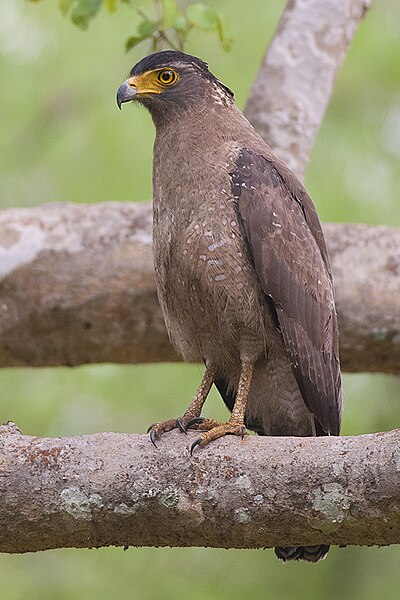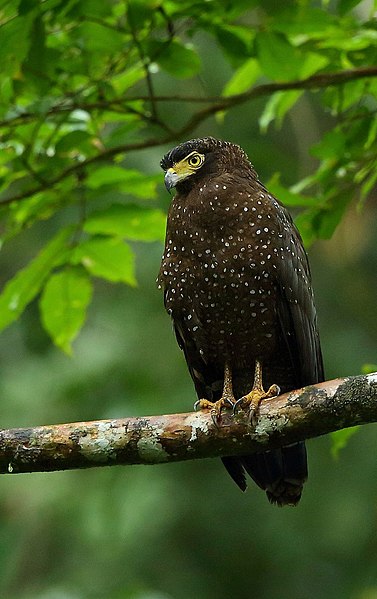Nicobar Serpent-Eagle Bird Details
Spilornis klossi
Nicobar Serpent-Eagle,South Nicobar serpent eagle;
Cheel
Charles Wallace Richmond, 1902
Accipitriformes (HAWKS, EAGLES and KITES)
Accipitridae
Spilornis
- India: Union Territory of Andaman and Nicobar Islands.
- Indonesia: Nearby islands in Indonesia.
Appearance :
The Nicobar Serpent-Eagle is a medium-sized raptor with a distinctive appearance. Generally dark brown with a mottled appearance. The head and upperparts are dark brown with lighter streaks, and the underparts are lighter with dark streaks. Legs Equipped with strong talons for catching prey.
Behaviour :
The Nicobar Serpent-Eagle has a slow, soaring flight and is often seen gliding. Typically solitary or found in pairs, they are territorial and maintain a specific range. They have a distinctive call, often a series of whistling notes.
Habitat :
Lowland and hill forests, particularly in tropical regions. They are found in the Nicobar Islands and parts of the surrounding region.
Diet :
Their diet mainly consists of small snakes, lizards, and occasionally small mammals or birds. They use their keen eyesight to spot prey from a perch or during flight.
Conservation Status :
Near Threatened
Distribution :
The Nicobar Serpent-Eagle is primarily found in the Nicobar Islands, which are part of India. They also have a presence in nearby regions of Southeast Asia.
Population Size :
It is considered to be relatively small and declining.
Life Span :
Typically around 10-15 years.
Body And Tarsus:
- Body: The Nicobar Serpent-Eagle has a robust and compact body structure, which is typical of raptors. It is adapted for a predatory lifestyle with strong talons and a powerful beak.
- Tarsus Length: Approximately 7.5–8 cm (3–3.1 inches).
Head And Bill :
- Head: The head is relatively small compared to the body and is adorned with a strong, hooked beak. The head plumage is darker with light streaks, providing some camouflage.
- Bill: The bill is strong, hooked, and ideal for tearing apart prey.
- Bill Length: About 4–5 cm (1.6–2 inches).
Length :
ypically ranges from 45 to 55 cm (17.7 to 21.7 inches) from beak to tail.
Neck :
The neck is moderately long, allowing for a good range of head movement, which is useful for spotting prey. It is well-adapted to their hunting and perching behavior.
Size :
Medium-sized raptor.
Tail Details :
- Tail: The tail is long and broad, helping with maneuverability during flight.
- Tail Length: Approximately 22–24 cm (8.7–9.4 inches).
Weight :
Generally around 800–1,000 grams (1.8–2.2 pounds).
Wing :
The wings are broad and rounded, which helps in soaring and gliding. They are well-adapted for slow, steady flight and maneuvering through dense forest.
Wing Span :
Approximately 1.2 to 1.5 meters (4 to 5 feet).
Facial Feature :
The Nicobar Serpent-Eagle has a relatively small head with a strong, hooked beak. The facial features are adapted for keen vision, which is essential for spotting prey.
Nest Details :
- Nest: The nest is usually built in tall trees, often in dense forested areas. It is a large, flat platform made of sticks and branches.
- Nest Composition: The nest is constructed from a variety of materials including sticks, twigs, and leaves. The interior may be lined with finer materials like grasses and feathers to provide a softer surface for the eggs.
Breeding Season :
Typically between December and April.
Nesting Season :
Takes place from late December through April.
Egg Color :
The eggs are typically white or off-white.
Egg Length :
Approximately 4.5–5.0 cm (1.8–2.0 inches).
Egg Width and Weight :
- Egg Width: Around 3.5–4.0 cm (1.4–1.6 inches).
- Egg Weight: Each egg weighs approximately 40–50 grams (1.4–1.8 ounces).
Clutch Size :
Usually consists of 1 to 2 eggs per breeding season.
No. of Broods :
Generally, they raise a single brood per year.
Incubation Period :
Typically lasts about 30–35 days.
Nestling Period :
The young birds fledge around 6–8 weeks after hatching.
Vocalization :
Their calls are a series of high-pitched whistles or screeches. These calls are used for communication between mates and to establish territory.
Sex Demorphism :
Differences in size or plumage are subtle and not typically noticeable without close examination.
Migration Details :
Migration Pattern: The Nicobar Serpent-Eagle is largely sedentary and does not undertake long migrations. They may exhibit some local movements in response to seasonal changes or food availability but generally remain within their established range.


